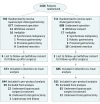Effect of Laparoscopic Distal Gastrectomy vs Open Distal Gastrectomy on Long-term Survival Among Patients With Stage I Gastric Cancer: The KLASS-01 Randomized Clinical Trial
- PMID: 30730546
- PMCID: PMC6459124
- DOI: 10.1001/jamaoncol.2018.6727
Effect of Laparoscopic Distal Gastrectomy vs Open Distal Gastrectomy on Long-term Survival Among Patients With Stage I Gastric Cancer: The KLASS-01 Randomized Clinical Trial
Abstract
Importance: Laparoscopic distal gastrectomy is gaining popularity over open distal gastrectomy for gastric cancer because of better early postoperative outcomes. However, to our knowledge, no studies have proved whether laparoscopic distal gastrectomy is oncologically equivalent to open distal gastrectomy.
Objective: To examine whether the long-term survival among patients with stage I gastric cancer undergoing laparoscopic distal gastrectomy is noninferior to that among patients undergoing open distal gastrectomy.
Design: The Korean Laparoendoscopic Gastrointestinal Surgery Study (KLASS) group, which includes 15 surgeons from 13 institutes, conducted a phase 3, multicenter, open-label, noninferiority, prospective randomized clinical trial (KLASS-01) of patients with histologically proven, preoperative clinical stage I gastric adenocarcinoma from January 5, 2006, to August 23, 2010. Survival and recurrence status of the patients was determined in December 2016.
Interventions: Patients were randomly assigned (1:1) to laparoscopic distal gastrectomy (n = 705) or open distal gastrectomy (n = 711). Of these patients, 85 received a surgical approach opposite the one to which they were randomized (63 randomized to the open surgery group and 22 to the laparoscopic group).
Main outcomes and measures: Difference in 5-year overall survival between the laparoscopic and open distal gastrectomy groups. The noninferiority margin was prespecified as -5% (corresponding hazard ratio of 1.54), with an assumed survival of 90% after 5 years in the open surgery group.
Results: Among the 1416 patients (mean [SD] age, 57.3 [11.1] years; 940 [66.4%] male) included in the study, the 5-year overall survival rates were 94.2% in the laparoscopic group and 93.3% in the open surgery group (log-rank P = .64). Intention-to-treat analysis confirmed the noninferiority of the laparoscopic approach compared with the open approach (difference, 0.9 percentage points; 1-sided 97.5% CI, -1.6 to infinity). The 5-year cancer-specific survival rates were similar between the 2 groups (97.1% in the laparoscopic group and 97.2% in the open surgery group, log-rank P = .91; difference, -0.03 percentage points; 1-sided 97.5% CI, -1.8 to infinity). Per-protocol analysis results were consistent with the intention-to-treat results for overall and cancer-specific survival rates.
Conclusions and relevance: The KLASS-01 trial revealed similar overall and cancer-specific survival rates between patients receiving laparoscopic and open distal gastrectomy. Laparoscopic distal gastrectomy is an oncologically safe alternative to open surgery for stage I gastric cancer.
Trial registration: ClinicalTrials.gov identifier: NCT00452751.
Conflict of interest statement
Figures



